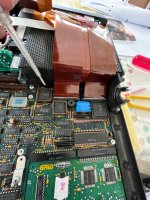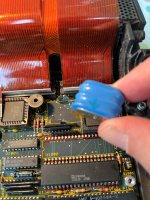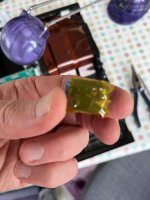Atomtan
Member
Hi Folks, I wonder if anyone can help.
I have bitten the bullet and dived into identifying whether my machine had the Dallas chip battery, or a physical battery itself.
Well I suspect its a battery (the light blue one), though I have never seen one like it before. When closely inspected, it appears it might 'clip out' as there are vertical tangs on either side of the battery, but I don't want to force it.
I was also surprised at the number and density of the ribbon cables coming over the floppy drive from the rear ports and connecting with vertical connectors just behind the battery onto the main board.
Following the logic that I will need to get to the underside of the main board to change the battery, I will need to disconnect these ribbons (at one end or the other). I cannot see any way of accessing the slide out tabs on the vertical ribbon connectors and so assume my only course of action is to remove the rear panel of the machine, release the ports individually from the case and try to release the back of the ribbon cables.
I am getting a little nervous now as I don't want to screw up. Any guidance would be very gratefully recieved.
I have bitten the bullet and dived into identifying whether my machine had the Dallas chip battery, or a physical battery itself.
Well I suspect its a battery (the light blue one), though I have never seen one like it before. When closely inspected, it appears it might 'clip out' as there are vertical tangs on either side of the battery, but I don't want to force it.
I was also surprised at the number and density of the ribbon cables coming over the floppy drive from the rear ports and connecting with vertical connectors just behind the battery onto the main board.
Following the logic that I will need to get to the underside of the main board to change the battery, I will need to disconnect these ribbons (at one end or the other). I cannot see any way of accessing the slide out tabs on the vertical ribbon connectors and so assume my only course of action is to remove the rear panel of the machine, release the ports individually from the case and try to release the back of the ribbon cables.
I am getting a little nervous now as I don't want to screw up. Any guidance would be very gratefully recieved.



